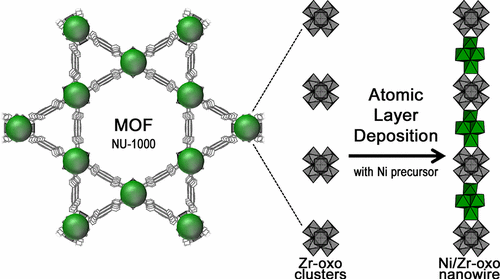当前位置:
X-MOL 学术
›
J. Am. Chem. Soc.
›
论文详情
Our official English website, www.x-mol.net, welcomes your feedback! (Note: you will need to create a separate account there.)
Bridging Zirconia Nodes within a Metal–Organic Framework via Catalytic Ni-Hydroxo Clusters to Form Heterobimetallic Nanowires
Journal of the American Chemical Society ( IF 15.0 ) Pub Date : 2017-07-24 00:00:00 , DOI: 10.1021/jacs.7b04997 Ana E. Platero-Prats 1 , Aaron B. League 2 , Varinia Bernales 2 , Jingyun Ye 2 , Leighanne C. Gallington 1 , Aleksei Vjunov , Neil M. Schweitzer , Zhanyong Li , Jian Zheng , B. Layla Mehdi , Andrew J. Stevens , Alice Dohnalkova , Mahalingam Balasubramanian 1 , Omar K. Farha 3 , Joseph T. Hupp , Nigel D. Browning 4 , John L. Fulton , Donald M. Camaioni , Johannes A. Lercher 5 , Donald G. Truhlar 2 , Laura Gagliardi 2 , Christopher J. Cramer 2 , Karena W. Chapman 1
Journal of the American Chemical Society ( IF 15.0 ) Pub Date : 2017-07-24 00:00:00 , DOI: 10.1021/jacs.7b04997 Ana E. Platero-Prats 1 , Aaron B. League 2 , Varinia Bernales 2 , Jingyun Ye 2 , Leighanne C. Gallington 1 , Aleksei Vjunov , Neil M. Schweitzer , Zhanyong Li , Jian Zheng , B. Layla Mehdi , Andrew J. Stevens , Alice Dohnalkova , Mahalingam Balasubramanian 1 , Omar K. Farha 3 , Joseph T. Hupp , Nigel D. Browning 4 , John L. Fulton , Donald M. Camaioni , Johannes A. Lercher 5 , Donald G. Truhlar 2 , Laura Gagliardi 2 , Christopher J. Cramer 2 , Karena W. Chapman 1
Affiliation

|
Metal–organic frameworks (MOFs), with their well-ordered pore networks and tunable surface chemistries, offer a versatile platform for preparing well-defined nanostructures wherein functionality such as catalysis can be incorporated. Notably, atomic layer deposition (ALD) in MOFs has recently emerged as a versatile approach to functionalize MOF surfaces with a wide variety of catalytic metal-oxo species. Understanding the structure of newly deposited species and how they are tethered within the MOF is critical to understanding how these components couple to govern the active material properties. By combining local and long-range structure probes, including X-ray absorption spectroscopy, pair distribution function analysis, and difference envelope density analysis, with electron microscopy imaging and computational modeling, we resolve the precise atomic structure of metal-oxo species deposited in the MOF NU-1000 through ALD. These analyses demonstrate that deposition of NiOxHy clusters occurs selectively within the smallest pores of NU-1000, between the zirconia nodes, serving to connect these nodes along the c-direction to yield heterobimetallic metal-oxo nanowires. This bridging motif perturbs the NU-1000 framework structure, drawing the zirconia nodes closer together, and also underlies the sintering resistance of these clusters during the hydrogenation of light olefins.
中文翻译:

通过催化镍氢簇在金属有机框架内桥接氧化锆节点,形成异双金属纳米线
金属有机骨架(MOF)及其有序的孔网络和可调节的表面化学性质,为制备定义明确的纳米结构提供了多功能平台,其中可以结合诸如催化的功能。值得注意的是,MOF中的原子层沉积(ALD)最近作为一种通用方法出现,可以用多种催化金属-氧代物质对MOF表面进行功能化。了解新沉积物质的结构以及如何将它们束缚在MOF中对于了解这些成分如何耦合以控制活性材料的特性至关重要。通过将局部和远程结构探针(包括X射线吸收光谱法,对分布函数分析和差异包络线密度分析)与电子显微镜成像和计算模型相结合,我们通过ALD解析了MOF NU-1000中沉积的金属-氧代物种的精确原子结构。这些分析表明,NiO的沉积x H y团簇选择性地出现在氧化锆节点之间的NU-1000最小孔中,用于沿c方向连接这些节点以产生异双金属金属-氧代纳米线。这种桥连基序扰动了NU-1000骨架结构,将氧化锆节点拉得更近,并且还成为轻质烯烃加氢过程中这些团簇的耐烧结性的基础。
更新日期:2017-07-25
中文翻译:

通过催化镍氢簇在金属有机框架内桥接氧化锆节点,形成异双金属纳米线
金属有机骨架(MOF)及其有序的孔网络和可调节的表面化学性质,为制备定义明确的纳米结构提供了多功能平台,其中可以结合诸如催化的功能。值得注意的是,MOF中的原子层沉积(ALD)最近作为一种通用方法出现,可以用多种催化金属-氧代物质对MOF表面进行功能化。了解新沉积物质的结构以及如何将它们束缚在MOF中对于了解这些成分如何耦合以控制活性材料的特性至关重要。通过将局部和远程结构探针(包括X射线吸收光谱法,对分布函数分析和差异包络线密度分析)与电子显微镜成像和计算模型相结合,我们通过ALD解析了MOF NU-1000中沉积的金属-氧代物种的精确原子结构。这些分析表明,NiO的沉积x H y团簇选择性地出现在氧化锆节点之间的NU-1000最小孔中,用于沿c方向连接这些节点以产生异双金属金属-氧代纳米线。这种桥连基序扰动了NU-1000骨架结构,将氧化锆节点拉得更近,并且还成为轻质烯烃加氢过程中这些团簇的耐烧结性的基础。



























 京公网安备 11010802027423号
京公网安备 11010802027423号